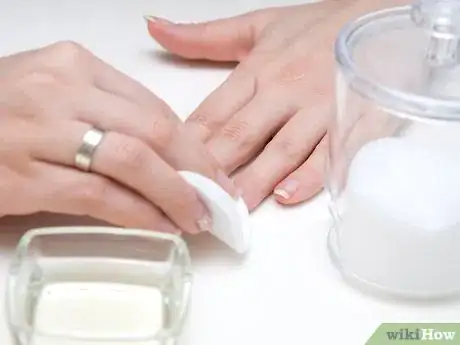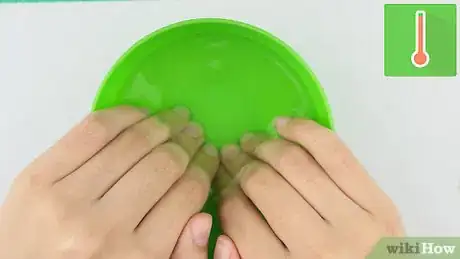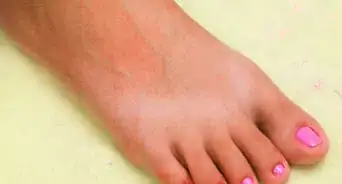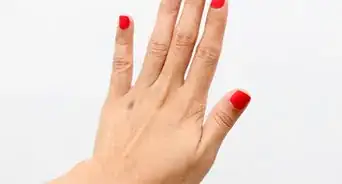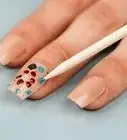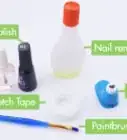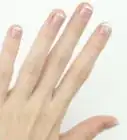This article was co-authored by Mia Rubie. Mia Rubie is a Nail Artist and the Owner of Sparkle San Francisco, a nail studio based in San Francisco, California. She has over eight years of nail artist and management experience and is known for her push-the-envelope designs and artistic eye for colors. Her clients include Sephora, Target, and Vogue. Her work has been featured in the San Francisco Chronicle and StyleCaster. She holds a BBA focusing on Entrepreneurial and Small Business Operations from San Francisco State University. You can find her work on her Instagram account @superflynails.
There are 11 references cited in this article, which can be found at the bottom of the page.
wikiHow marks an article as reader-approved once it receives enough positive feedback. In this case, 94% of readers who voted found the article helpful, earning it our reader-approved status.
This article has been viewed 588,032 times.
Applying neat, even layers of nail polish is extremely tricky. Getting a clean and crisp nail polish line takes practice, patience, and a steady hand. If you happen to paint outside the lines, you can always clean up your mistakes!
Things You Should Know
- Add a thin layer of petroleum jelly or white school glue around each nail to shield your skin from the polish and create crisp lines.
- Wait for each layer of polish to dry before painting on the next one. Aim to use no more than 3 brush strokes per nail.
- Remove the petroleum jelly or glue. If there’s still polish on your skin, dab an old makeup brush in nail polish remover and wipe along your nail polish line.
Steps
Preparing Your Nails for Polish
-
1Remove old polish from your nails. In order to produce a neat and even manicure, you must first remove any old polish from your nails. Acetone nail polish removers dry out your nail, and cuticle. If possible, use a non-acetone nail polish remover over an acetone nail polish remover.[1]
- Place a cotton swab or ball over the opening of your nail polish remover. Make sure it is completely covering the opening of the bottle.
- Tip the bottle upside down and wait a few seconds for the cotton swab or ball to become saturated with the remover.
- Rub the saturated cotton swab or ball over your nails to remove the polish.
- Re-saturate your cotton swab or ball as needed.[2]
-
2Trim, file and smooth your nails. After removing your old nail polish, devote some time to clipping, shaping and buffing your nails. Locate nail clippers, emery board and a gentle buffer.[3]
- Use the clippers to trim your nails, if needed.
- Smooth the edges of your nails with an emery board nail file. File your nails into a round, square, or rounded-square shape.
- Run over each nail with a slightly abrasive buffer to even out the surface of your nails.[4]
Advertisement -
3Soak your hands in warm water. Once your nails are clipped, shaped, and buffed, take a moment to relax and pamper yourself. Retrieve a basin and fill it with warm water and a squirt of your gentle facial cleanser. Use a gentle body scrub to exfoliate your hands before soaking them. Submerge your hands in the warm, soapy water to remove the body scrub. Soak your hands for three minutes. Remove your hands from the basin and dry them on a clean towel.
- After soaking your hands, your cuticles will be soft and easier to push back.[5]
-
4Push back your cuticles. Do not do this if it starts really hurting as this could cause them to bleed. It might hurt just a little whilst you do it if you haven't done it for a while. Cuticles are a part of your skin. They protect your nail matrix, the portion of the nail that grows, from infection. Cutting your cuticles leaves your nail matrix open to infections. It can also cause deformities in the nail, such as ridges and discoloration. Instead of cutting your cuticles, push them back to give your nail an oval appearance. It also makes it easier to create a neat polish line.
- Use a cuticle pusher to carefully push the cuticle back towards your nail bed.
- Push in the sides of the cuticle as well.
- Remove any dry or damaged skin.
- Repeat on the rest of your nails.[6]
-
5Moisturize your cuticles and skin. After exfoliating your hands, it is important to rehydrate and moisturize your soft skin. Select a thick and luxurious hand cream or lotion. Massage this cream or lotion into your hands. Or, apply some almond oil (usually comes in a pen or a nail varnish type pot) or some clearly labeled cuticle oil and apply to your cuticles. This hydrates them and the remaining white half-dead skin will properly get dealt with.[7]
-
6Remove oil and grease from your nails. If left on your nails, the oils from your hand cream or lotion will shorten the life of your polish. You can remove these oils from your fingernails with rubbing alcohol and a cotton swab or ball.
- Place a cotton swab or ball over the opening of the rubbing alcohol bottle.
- Tip the bottle upside down and wait a moment for the cotton swab or ball to become saturated with the rubbing alcohol. Place the bottom of the bottle on a flat surface.
- Swipe the rubbing alcohol-saturated cotton swab or ball over your nails to remove the oil.
- Repeat as needed.
Using Different Tricks to Keep Your Nail Polish Neat
-
1Apply a thin layer of petroleum jelly around each nail before painting your nails. Before painting your nails, you can take measures to prevent the polish from drying outside the lines of your nails. You can achieve a perfectly neat mani every time by placing a thin layer of petroleum jelly around the edge of your nail. The oil from the vaseline will serve as a barrier between your skin and the nail polish.
- Dab a cotton bud into a jar of petroleum jelly. If you don’t have vaseline, you can use lotion.
- Swipe the cotton bud around the edges of each nail—keep the cotton bud and petroleum jelly on your skin. Do not let either touch your nail.
- Pick out your polish and get ready to paint your nails.[8]
Expert AnswerQWhen asked, “How can you apply nail polish without getting it on your skin?”
Marta Nagorska is a Nail Technician and Nail Art Blogger based in London, UK. She runs the blog, Furious Filer, where she gives tutorials on nail care and advanced nail art. She has been practicing nail art for over 5 years and graduated from Northampton College with distinction with a Nail Technician and Manicurist degree in 2017. She has been awarded the top spot in the OPI Nail Art Competition.Nail Artist
 EXPERT ADVICEAnswer from Marta Nagorska:
EXPERT ADVICEAnswer from Marta Nagorska:Marta Nagorska, a nail technician, responded: “There is liquid latex that you can brush on around your nails before you paint them. Let it dry for a minute and apply polish as usual. If you accidentally apply polish on your skin, simply peel off the liquid latex and any polish that is not on your nails will come off with it. Liquid latex even comes in various color and glitter options and there are non-latex alternatives for people with allergies.”
-
2Apply a thin coat of white school glue around each nail prior to polishing your nails. If you struggle to paint inside the lines of your nails, you can take steps to ensure a swift and neat clean-up. Apply a thin coat of white school glue around the edge of your nails to create a neat, crisp polish line. The glue will protect your skin from the polish.
- Dip a cotton bud or brush into a bottle of white school glue.
- Use the cotton bud or brush to paint a thin, even layer of white school glue around the edge of each of your nails. Do your best to keep the glue off your nails.
- Wait for the glue to dry before you polish your nails.[9]
-
3Wait to clean up your nail polish line. As you continue to improve at painting your nails, you may have less errant nail polish to remove from your skin. Instead of applying a thin coat of petroleum jelly or white school glue, you may choose to clean up your nail polish lines after you’ve finished applying your polish and top coat. You can perfect your polish line with an old makeup brush and nail polish remover. This method requires a steady, practiced hand and patience.
- You may also use a clean cotton-bud dipped in nail polish remover.
Painting and Drying Your Nails
-
1Apply a base coat to each nail and wait for it to dry. Base coats strengthen and protect your nails. This first layer of your manicure also extends the life of your polish. Coat each nail in a thin, even layer of base coat. Allow the base coat to dry.[10]
- Swipe the brush on the inside of the bottle’s opening to remove excess base coat from the brush.
- While you should always use a base coat, it is especially important to use this product if your nails frequently chip, split, or peel. The base coat will help to fortify your nails.[11]
-
2Apply the first thin coat of polish in three strokes and allow it to dry. In order to achieve a nice, neat, and even manicure, apply one to three thin layers of polish. You can control the thickness of each coat by only leaving enough polish on your brush to cover one nail. Remove excess polish from your brush by sliding your brush up the inside of the bottle’s opening from base to tip. Once you have just enough polish on your brush, apply the paint in three strokes
- Place a small dab of polish at the base of your nail above your cuticle. (This prevents the polish from pooling.)
- Use the brush to pull the dab of polish down towards the cuticle—do your best to leave a small gap of nail between the polish and your cuticle.
- Swipe the brush in a straight line from the base to the tip of your nail.
- Return the brush to the base of your nail. Move the brush upwards along the left curve of your nail until the entire side is coated in polish.
- Return the brush to the base of your nail. Move the brush upwards along the right curve of your nail until the entire side is coated in polish.
- Repeat this process on each nail.
- Allow the polish to dry before adding another coat.[12]
-
3Apply a second and/or third thin coat of polish in three strokes and let it dry. As your first coat dries, determine if you need to add a second layer of polish. If your polish is sheer, you may want to add two or more coats; if your polish is opaque, you may not need to add a second and/or third coat. Once your first coat of polish is dry, apply a second coat of polish if desired.
- Put a small dot of nail polish at the base of your nail just above your cuticle.
- Pull the dot of polish down towards the cuticle with the brush—try to leave a small gap of nail between the polish and your cuticle.
- Pull the brush in a straight line from the base to the tip of your nail.
- Place the brush at the base of your nail. Swipe the brush along the left curve of your nail until the entire side is coated in polish.
- Place the brush at the base of your nail. Pull the brush upwards along the right curve of your nail until the entire side is coated in polish.
- Repeat this process on each nail.
- Allow the polish to dry before adding a third coat or applying a top coat.[13]
-
4Apply an even layer of top coat to each nail and wait for it to dry. Top coat adds a brilliant shine to your polished fingers. Once your nails are completely dry, apply a thin layer of top coat to each nail. If possible, apply a quick-drying top coat to your nails.[14]
- Soak your fingernails in ice water to help your polish cure faster.[15]
Cleaning Up Your Polished Nails
-
1Use a cotton-bud to remove the petroleum jelly from around each nail. If you applied a thin coat of petroleum jelly around the edge of your nails, allow your nails to dry completely before you remove the substance. Once the top coat is dry, trace the edges of your nails with a clean cotton-bud. As you remove the petroleum jelly from your skin, you will also wipe away any polish sitting on top of the oily substance.[16]
-
2Peel off the thin coat of glue and excess nail polish from around each nail. When your nails are dry, carefully remove the thin layer of dried white school glue from your skin. As you peel away the dried glue, you will also remove any polish that is outside of your nail polish line. Once removed, you will be left with a neat and crisp nail polish line.[17]
-
3Clean up excess polish with an old makeup brush and nail polish remover. After painting your nails, you can carefully remove any excess polish with an old makeup brush dipped in nail polish remover. In addition to a brush a remover, you will also need a cotton swab or ball. When you’re done touching up your nail polish lines, you’ll be left with a pristine manicure.
- Pour out a small amount of nail polish remover into a dish or the bottle’s cap.
- Dip your brush into the remover and then blot it on a clean cotton swab or ball.
- Position the brush next to your untidy nail polish line.
- Without applying any pressure, sweep the brush along your nail polish line. Repeat on each nail polish line.
- Use the brush to remove nail polish that dried on your skin.[18]
- Dip your brush in the remover and wipe your it off on the cotton swab or ball as needed.[19]
Community Q&A
-
QuestionIf I don't have a top coat, can I just apply the base coat once more after applying the polish?
 Community AnswerYou can, but I have found that doing so makes my polish more prone to peeling and chipping.
Community AnswerYou can, but I have found that doing so makes my polish more prone to peeling and chipping. -
QuestionMy son asked me to paint his nails. He's never really been that girly at all, should I say yes to it?
 Community AnswerIt would be perfectly fine for you to have fun and paint his nails. That said, depending on his age, it may be a good idea to remove the nail polish before he goes to school so that he can avoid potential bullying. Although bullying is completely wrong, it does happen. If he is emotionally strong enough to handle potential bullying, then he can probably go to school with his nails painted. It is up to you, your son, his age and his maturity and self confidence.
Community AnswerIt would be perfectly fine for you to have fun and paint his nails. That said, depending on his age, it may be a good idea to remove the nail polish before he goes to school so that he can avoid potential bullying. Although bullying is completely wrong, it does happen. If he is emotionally strong enough to handle potential bullying, then he can probably go to school with his nails painted. It is up to you, your son, his age and his maturity and self confidence. -
QuestionCan I still polish my nails with just nail polish if I don't have base coat and top coat?
 Community AnswerIf you do not have a base coat and top coat, you can still polish your nails. It just won't look as neat as if you were to use the base and top coat.
Community AnswerIf you do not have a base coat and top coat, you can still polish your nails. It just won't look as neat as if you were to use the base and top coat.
Things You'll Need
- Nail clippers
- File
- Nail buffer
- Warm water
- Basin
- Gentle facial cleanser
- Body scrub
- Basecoat
- Nail polish
- Topcoat
- Cotton swabs, balls, and or buds
- Nail polish remover
- White school glue
- Vaseline
References
- ↑ Mia Rubie. Nail Artist. Expert Interview. 23 April 2020.
- ↑ http://www.makeupsavvy.co.uk/2010/10/how-to-perfectly-apply-nail-polish.html, http://www.paulaschoice.com/expert-advice/body-care/_/how-to-give-yourself-a-manicure-at-home
- ↑ Mia Rubie. Nail Artist. Expert Interview. 23 April 2020.
- ↑ http://www.cosmopolitan.com/style-beauty/beauty/how-to/a5101/things-about-painting-your-nails-you-might-not-know/, http://www.paulaschoice.com/expert-advice/body-care/_/how-to-give-yourself-a-manicure-at-home
- ↑ http://www.paulaschoice.com/expert-advice/body-care/_/how-to-give-yourself-a-manicure-at-home
- ↑ http://www.webmd.com/beauty/nails/caring-for-your-cuticles
- ↑ Mia Rubie. Nail Artist. Expert Interview. 23 April 2020.
- ↑ http://www.cosmopolitan.com/style-beauty/beauty/advice/a6317/nail-art-hacks/
- ↑ http://www.cosmopolitan.com/style-beauty/beauty/advice/a6317/nail-art-hacks/
- ↑ Mia Rubie. Nail Artist. Expert Interview. 23 April 2020.
- ↑ http://www.makeupandbeautyblog.com/nails/7-steps-to-a-perfect-diy-manicure/, http://www.paulaschoice.com/expert-advice/body-care/_/how-to-give-yourself-a-manicure-at-home
- ↑ http://www.makeupandbeautyblog.com/nails/7-steps-to-a-perfect-diy-manicure/
- ↑ http://www.makeupandbeautyblog.com/nails/7-steps-to-a-perfect-diy-manicure/
- ↑ http://www.makeupandbeautyblog.com/nails/7-steps-to-a-perfect-diy-manicure/, http://www.paulaschoice.com/expert-advice/body-care/_/how-to-give-yourself-a-manicure-at-home
- ↑ http://www.cosmopolitan.com/style-beauty/beauty/advice/a6317/nail-art-hacks/
- ↑ http://michellephan.com/polish-up-how-to-use-vaseline-better-manicure/, http://www.cosmopolitan.com/style-beauty/beauty/advice/a6317/nail-art-hacks/
- ↑ http://www.cosmopolitan.com/style-beauty/beauty/advice/a6317/nail-art-hacks/, http://www.xovain.com/nails/elmers-glue-nail-polish-trick
- ↑ Mia Rubie. Nail Artist. Expert Interview. 23 April 2020.
- ↑ http://www.lacquerized.com/2010/02/clean-up-in-6-easy-steps.html
About This Article
To apply nail polish neatly, remove any old nail polish, and trim and file your nails to your desired shape and length. Then, apply a thin layer of petroleum jelly around each nail to act as a barrier between your skin and any polish that might not stay on the nail. If you have trouble painting inside the lines, dab white school glue around each nail and let it dry. When you finish paining your nails and the polish has dried, peel off the glue to remove any excess polish around the nail. For tips on cleaning up polished nails, read on!
